SCORE Annual Summary Report 2014-15
SCORE is a collection of information from Registered Social Landlords about the new lets they make in a given year.
Rent, Income and Affordability[1]
Average Weekly Rent by Area - SST General Needs lets only
The average weekly rent figures shown in Table 4 below are for Housing Association General Needs lettings only and only include Scottish Secure Tenancies (SSTs), 87% of lets were recorded as such. Supported lets have been excluded as the associated rents tend to be higher and there is uneven distribution of supported units throughout the country.
For Scotland, the average weekly rent for 2014-15 was £72.18, a 4.5% rise from 2013-14. Lettings to properties in South Ayrshire had the highest average weekly rent figure at £81.94, Perth & Kinross had the lowest average at £65.68.
Table 4: Average Rent by Local Authority - SST General Needs Lettings Only, 2013/14 and 2014/15
| 2013/14 | 2014/15 | |
| Aberdeen City |
£72.61 | £74.78 |
| Aberdeenshire |
£71.46 | £74.98 |
| Angus |
£66.75 | £71.71 |
| Argyll & Bute |
£67.54 | £70.71 |
| Clackmannanshire |
£70.19 | £74.52 |
| Dumfries & Galloway |
£66.75 | £68.46 |
| Dundee City |
£63.47 | £68.37 |
| East Ayrshire |
£75.30 | £78.92 |
| East Dunbartonshire |
£73.04 | £73.85 |
| East Lothian |
£76.14 | £77.83 |
| East Renfrewshire |
£74.72 | £73.46 |
| Edinburgh, City of |
£76.01 | £78.60 |
| Eilean Siar |
£67.26 | £70.45 |
| Falkirk |
£66.91 | £69.15 |
| Fife |
£69.79 | £74.31 |
| Glasgow City |
£67.10 | £72.24 |
| Highland |
£71.28 | £73.10 |
| Inverclyde |
£70.84 | £72.97 |
| Midlothian |
£74.46 | £76.09 |
| Moray |
£69.30 | £70.17 |
| North Ayrshire |
£76.30 | £75.58 |
| North Lanarkshire |
£68.96 | £70.60 |
| Orkney Islands |
£67.25 | £68.26 |
| Perth & Kinross |
£67.95 | £65.68 |
| Renfrewshire |
£70.88 | £70.60 |
| Scottish Borders |
£64.86 | £67.73 |
| Shetland Islands |
£75.87 | £75.35 |
| South Ayrshire |
£77.14 | £81.94 |
| South Lanarkshire |
£70.94 | £74.93 |
| Stirling |
£71.96 | £70.88 |
| West Dunbartonshire |
£63.77 | £67.07 |
| West Lothian |
£71.15 | £72.93 |
| Scotland |
£69.12 | £72.18 |
Average Weekly Rent by Property Size and Household Type - All Lets
Rent levels can be affected by numerous factors such as property size (and, consequently, household type), whether they are a new or existing property and whether they are furnished. Where households are on low incomes they may receive Housing Benefit (or the housing element of universal credit) to pay all or part of their rent.
The average weekly rent in 2014-15 varied from £63.43 in a bedsit to £88.18 in a property with four or more bedrooms.
Correspondingly average rent levels were highest amongst households made up of three or more adults and a child or children. Such households paid, on average, £86.09 per week in rent.
The lowest average weekly rent - £67.46 - was paid by single adult households.
Chart 11: Average Weekly Rent by Household Type, 2013/14 and 2014/15
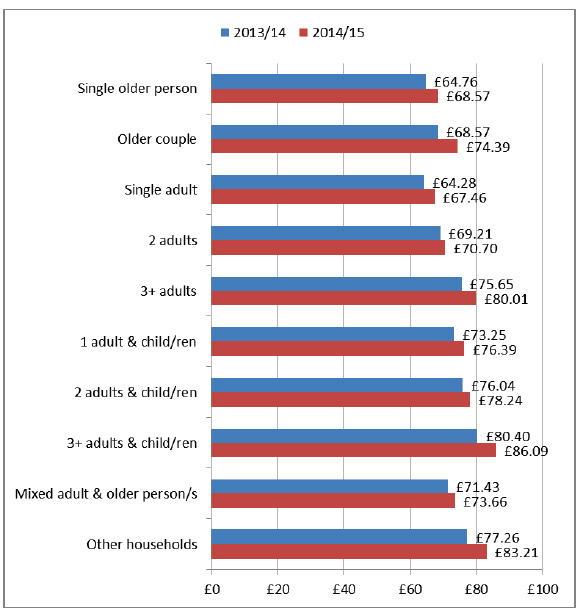
Average Weekly Rent by Tenancy Type
Scottish Secure Tenancies (SSTs - the most common tenancy type amongst social tenants) accounted for the vast majority of lettings recorded in SCORE (97.9% for 2014-15). Short Scottish Secure Tenancies (Short SSTs - these can be offered by social landlords in a small number of defined circumstances) accounted for only 1.4% of lettings in 2014-15 - the remaining 0.7% of lets were Occupancy agreements. Full definitions of SST and Short SST tenancies can be found here: www.scotland.gov.uk/Topics/Built-Environment/Housing/16342/management/tenantrights
The average weekly rent in 2014-15 for SST lettings was £71.72, up 4.3% from £68.77 in 2013-14. The average weekly rent for Short SST lettings was £73.97, up by 14.2% from £64.78 in 2013-14 and now higher than the equivalent SST figure. This increase may be because a relatively large proportion of the Short SST lets in 2014-15 were to newly built properties which are often associated with larger rents.
The overall percentage increase in average weekly rent since 2007-08 was 32.4% (£17.56) for SST and 46.0% (£23.32) for Short SST.
Chart 12: Average Weekly Rent by Tenancy Type, 2007/08 to 2014/15
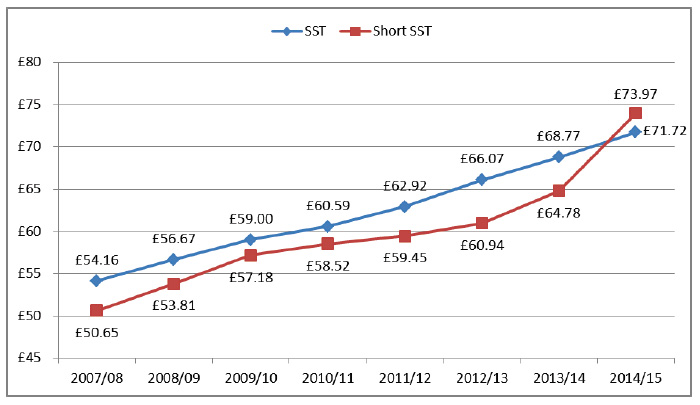
Average Weekly Rent & Charges by Design Type
Housing costs consist of the basic rent plus any additional charges. There are two categories of charges: service charges which are eligible for Housing Benefit, such as the provision of cleaning services, and other charges (such as charges for prepared food, sports facilities, personal laundry or personal care) which are not eligible for Housing Benefit.
The lowest housing costs were for dwellings designed for general purpose use at £74.00, an increase of £2.42 from 2013-14. These general purpose (or general needs) properties account for the majority of lettings recorded in SCORE, 85% in 2014-15.
Sheltered housing for older people accounted for around a tenth of the dwellings let during 2014-15. This type of housing provides a number of features in addition to the standards for general needs housing (such as an emergency call service and possibly a warden) and so the costs associated with it are higher. The average weekly cost for such properties was £118.39, up by £6.55 from last year when the weekly rent was £111.84.
Amenity/Alarm properties, which are either similar to sheltered housing but without the warden or are not adapted but have a community alarm, made up 4% of all lettings in 2014-15. Average housing costs for these properties rose by £1.84 per week (a 2.5% increase) between 2013-14 and 2014-15 - from £75.42 to £77.26.
Finally, housing costs for shared living accommodation, which accounted for less than 1% of properties let during 2014-15, increased significantly from £116.13 in 2013-14 to £137.23 in 2014-15. The small number of shared living accommodation lets made each year means that large variations such as this are likely.
Chart 13: Average Weekly Housing Costs by Design Type of Property, 2013/14 and 2014/15
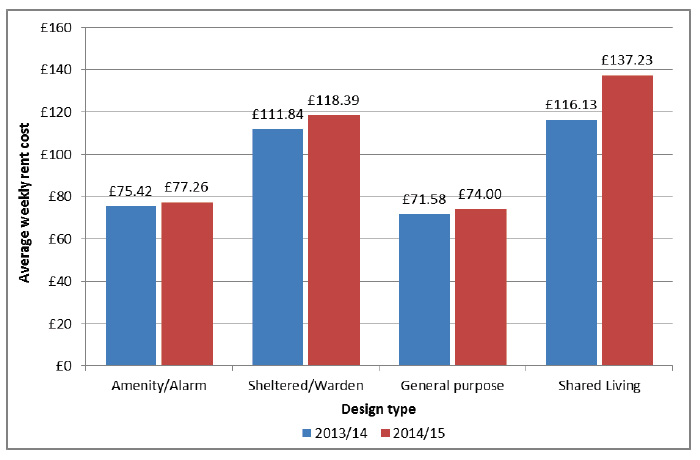
Average Weekly Household Income by Local Authority
NOTE: The remainder of this document makes use of income data collected through the SCORE form. Whilst a total of 19,564 SCORE forms were submitted many of these did not include completed income information. Income information was provided for 8,370 lettings (43%). No attempt has been made to account for this missing information and so care should be taken when using the income, Housing Benefit eligibility and affordability figures.
The average weekly household income for all lettings for 2014-15 across all of Scotland was £236.32, £9.74 (4.3%) higher than in 2013-14.
The average weekly household income will depend upon the household type and their economic status amongst other things and this needs to be kept in mind when comparing average income over time or between areas.
For example households with new lets in Shetland Islands had the highest average weekly household income of any local authority in Scotland (£367.86 in 2014-15). This can be partly explained by the high proportion of households working full-time (53%).
Meanwhile the lowest average weekly household income was recorded for Inverclyde at £184.04. Only 14% of lettings recorded for Inverclyde were to households working full-time whilst 39% were unemployed.
Chart 14: Average Weekly Household Income by Local Authority, 2013/14 and 2014/15

Average Weekly Household Income by Household Type and by economic status
Average weekly income has increased across most household types, the exceptions being those with 3 or more adults and no children and 'other' households that do not fit into any other category.
Perhaps not surprisingly, the highest average weekly household income was found amongst household with 3 or more adults and at least one child at £432.00. The lowest was for single adult households at £158.65.
Chart 15: Average Weekly Household Income by Household Type, 2013/14 and 2014/15

Similarly, average weekly income varies between households of different economic statuses. The highest average weekly income was, not surprisingly, amongst households working full-time (£382.40) although this fell slighlty compared to 2013-14. The lowest was amongst unemployed households (£127.74) and those in training (£129.20).
Chart 16: Average Weekly Household Income by Economic Status, 2013/14 and 2014/15

Housing Benefit Eligibility All Households
The rules around Housing Benefit changed in April 2013. Under the new rules the level of Housing Benefit paid to working age households deemed to have 1 or more spare bedroom may be reduced. Whilst in most cases the information collected by SCORE allows us to determine whether a household has a spare room it cannot account for all of the factors used to determine this. Further details can be found in the annex.
This section presents results based on a best estimate of Housing Benefit eligibility based on the rules introduced in April 2013. Results are shown for the proportion of households receiving full housing benefit (where the housing benefit fully covers a household's rent), partial housing benefit (where the household receives housing benefit but it doesn't fully cover their rent) and no housing benefit.
Chart 17: Housing Benefit Eligibility, all households, 2013/14 and 2014/15
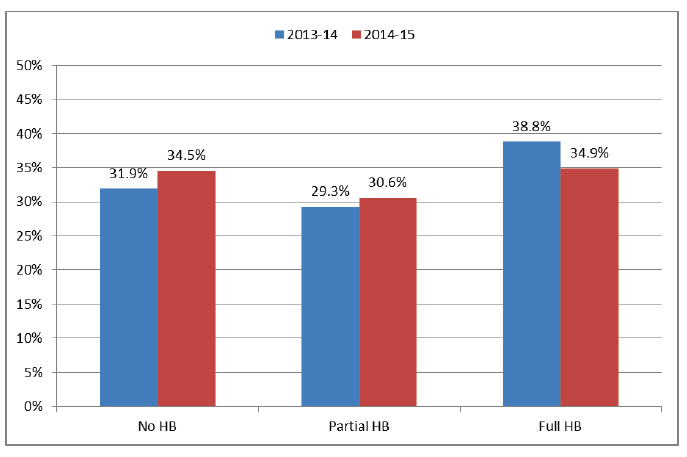
Chart 17 shows that fewer households received full HB in 2014-15 than in 2013-14 (34.9% compared to 38.8%) and very slightly more received partial HB (30.6% compared to 29.3%). Overall fewer households were eligible (65.5% compared to 68.1%).
Housing Benefit Eligibility for All Working Households
Chart 18: Housing Benefit Eligibility All Working Households, 2013/14 and 2014/15
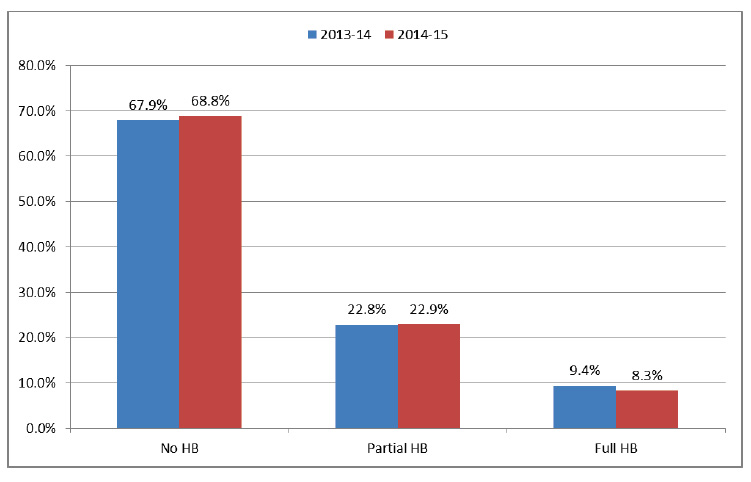
Compared to 2013-14, slightly fewer working households received full HB in 2014-15 (8.3% compared to 9.4%) and very slightly more received partial HB (22.9% compared to 22.8%). Overall slightly fewer households qualified for HB (31.2% compared to 32.1%).
Affordability Measure for Full-time Working Households
The affordability measure used by SCORE and defined by the Scottish Federation of Housing Associations (SFHA) is that a member of the household working 35 hours per week or more should have an income which allows the rent to be paid without reliance on Housing Benefit i.e. if in full-time employment, one should not need Housing Benefit for rent to be affordable. If a household is not eligible for housing benefit then it is deemed to 'pass' the affordability test. If, on the other hand, it is eligible for housing benefit then it 'fails' the test.
The affordability pass rate for full-time working households in 2014-15 was 84.5%, up very slightly from 83.4% in 2013-14.
Chart 19: Affordability Measure Full-time Working Households, 2013/14 and 2014/15
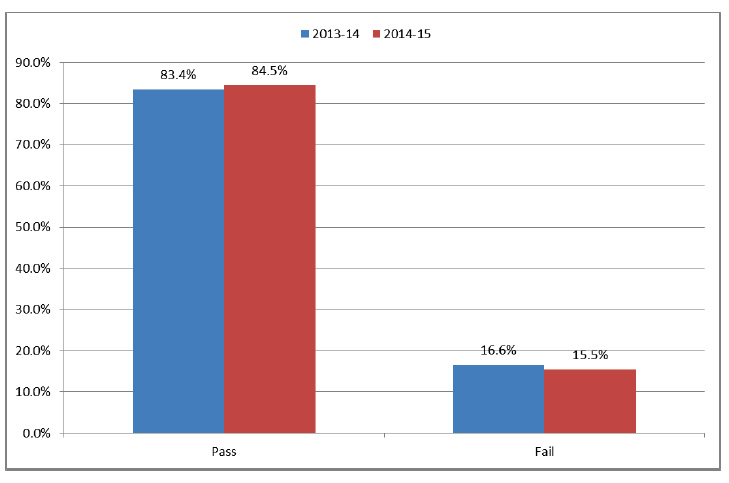
Contact
Email: Andrew White
There is a problem
Thanks for your feedback